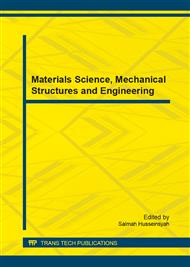p.529
p.534
p.539
p.543
p.547
p.551
p.557
p.561
p.566
Finite Element Analysis of Concrete Filled Double Skin Steel Tubes for Wind Turbine Tower
Abstract:
In order to save the steel consumption,ensure the better economy of wind turbine tower,this paper designeda new concrete filled double skin steel tube for wind turbine tower,based on the parameters of 1. 5 MW wind turbine tower.A three-dimensional finite element model of wind turbine tower was built by using the finite element software ANSYS,then the static strength analysis and modal analysis were carried out,in which the stress and displacement at the top of the tower were calculated under three kinds of working conditions: normal operation with rated wind speed,normal operation with cutout wind speed and shutdown under extreme wind conditions,the natural frequency and mode shapes of the tower were obtained as well. The results show that the tower does not resonate with blades,and its structure can meet the strength and stiffness requirements of engineering.
Info:
Periodical:
Pages:
551-556
Citation:
Online since:
October 2014
Authors:
Price:
Сopyright:
© 2014 Trans Tech Publications Ltd. All Rights Reserved
Share:
Citation:


